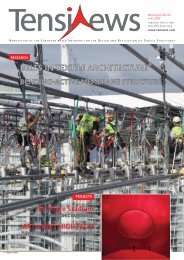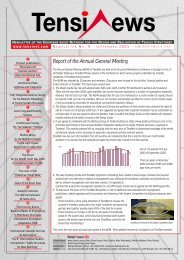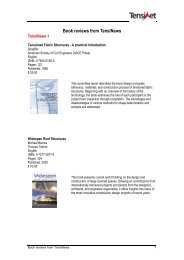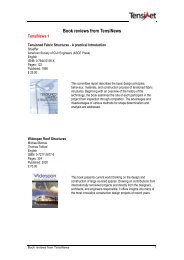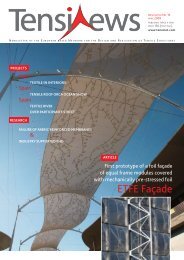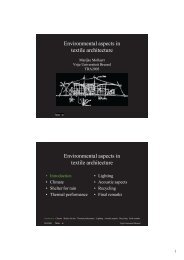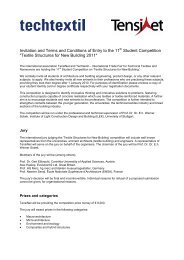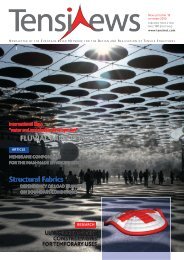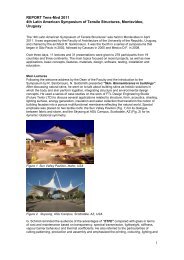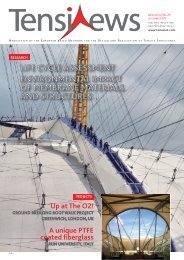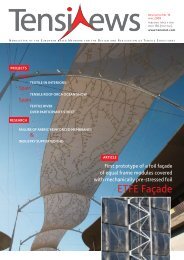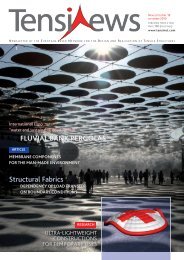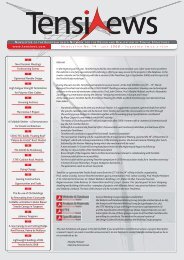TensiNews 13 - TensiNet
TensiNews 13 - TensiNet
TensiNews 13 - TensiNet
Create successful ePaper yourself
Turn your PDF publications into a flip-book with our unique Google optimized e-Paper software.
TENSINEWS NR. <strong>13</strong> – DECEMBER 2007<br />
14<br />
A possible new approach for<br />
computational mechanics &<br />
textile materials science<br />
To successfully represent complex non-linear<br />
fabric test data for a wide range of fabrics<br />
(including as yet untested fabrics) requires a<br />
method with no a priori assumptions about the<br />
form of the response, the level of warp-fill<br />
interaction or the distribution of the data<br />
points. Development of the planar response<br />
surface given by plane-stress theory leads to<br />
surface fitting methods such as bi-linear or<br />
polynomial representations. Any such method<br />
will result in some simplification of the original<br />
data, and may need to be modified for different<br />
types of fabric. For example, Testa, Stubbs and<br />
Spillers’ bi-linear representation of fabric<br />
stress-strain behaviour requires the ‘change<br />
point’ to be modified for each test. It has<br />
already been established that fabric shear and<br />
bending do not correspond to the conventional<br />
definitions used for engineering materials.<br />
It is proposed that response surfaces are used,<br />
but without the constraining assumptions of<br />
plane-stress which are not appropriate for<br />
describing architectural fabric behaviour.<br />
Previous researchers have used fabric tests<br />
carried out at a limited number of stress ratios<br />
(Day, 1986; MSAJ/M-02-1995; Minami et al,<br />
1997; Blum, 2002). Using a new test protocol<br />
that explores numerous stress states a much<br />
wider population of the data space can be<br />
determined. The test regime is stress<br />
controlled, which is appropriate as the range of<br />
expected stresses is known and the strains are<br />
required. However, during finite-element<br />
structural analysis, displacements are<br />
calculated from which warp and fill strains are<br />
determined and the corresponding stresses are<br />
required. Hence strain-strain-stress response<br />
surfaces are required to visualise the material<br />
response as it will be used in finite element<br />
analysis (Figures 4 & 5). It is proposed that<br />
direct correlation between pairs of strains and<br />
corresponding pairs of stresses can be used for<br />
structural analysis. This avoids the inherent<br />
Figure 4. Strain-strain-stress representation of test data,<br />
Ferrari 1202T PVC-polyester, two views<br />
approximations and inaccuracy incurred when<br />
non-linear fabric behaviour is represented using<br />
a plane stress model.<br />
The strain-strain-stress surfaces are very steep<br />
compared with the corresponding stress-stressstrain<br />
surfaces. Small changes in displacement<br />
(strain) give large changes in stress.<br />
The opposite is also true – small changes in<br />
stress generating large strains, especially during<br />
crimp interchange. This will potentially make<br />
analysis using this data unstable. However, this<br />
is not a problem caused by this method; it is an<br />
inherent characteristic of the fabric response.<br />
For accurate representation of fabric behaviour<br />
this highly sensitive response must be included<br />
in the analysis. Numerical stabilisation<br />
techniques such as arc length control found in<br />
elasto-plastic analysis may be effective in<br />
maintaining the non-linear solution stability. The<br />
steep gradient of the strain-strain-stress surfaces<br />
increases the importance of including the<br />
variability of the test results. When direct<br />
correlation between strains and stresses is used<br />
in a finite element analysis, surface gradients<br />
are not required. Consequently, a differentiable<br />
surface function does not need to be defined,<br />
unlike when Young’s modulus is required as part<br />
of a plane stress framework. The test data is<br />
included in the analysis with little modification,<br />
and no prior assumption about the form of the<br />
response. However, for an elastic analysis<br />
residual strain will need to be removed.<br />
Various interpolation schemes exist to fit local<br />
surface patches on to a specified number of<br />
‘nearest neighbours’ to the point of interest<br />
(Chivate & Jablokow, 1995; Jüttler & Felis,<br />
2002; Weiss et al, 2002).<br />
For simplicity, use of a triangular interpolation<br />
scheme is proposed to provide reliable, linear<br />
interpolation. Three pairs of strains (data<br />
points) are chosen which form a triangle<br />
enclosing the pair of strains for which stresses<br />
are required (Figure 6). The position of the<br />
strain data point within the triangle is used to<br />
Figure 5. Strain-strain-stress mean surfaces, Ferrari 1202T<br />
PVC-polyester, two views<br />
interpolate between the three pairs of stresses<br />
at the apexes of the triangle. Interpolation<br />
within the triangle can be carried using area<br />
coordinates (Cook et al, 1989).<br />
This interpolation scheme provides a simple,<br />
workable solution. Alternative approaches<br />
include a local polynomial ‘patch’ surface fitted<br />
to a given number of neighbouring points and<br />
its use to determine stresses at the point of<br />
interest, genetic algorithms (GA) or genetic<br />
programming (GP) to generate two functions<br />
for the warp and fill strain-strain-stress<br />
response surfaces. GAs and GPs would avoid<br />
the need for a database of test values and<br />
interpolation during the analysis. However,<br />
a function which correlates perfectly with the<br />
test data (i.e. passes through all data points)<br />
may not provide sensible results between data<br />
points (similar to the poor interpolation<br />
provided by mean and difference functions).<br />
Even if testing is carried out to failure, extra -<br />
polation beyond the tested stress states may<br />
be required in the following potential scenarios:<br />
1. A structure with higher stresses which will<br />
need some modifications to reduce the fabric<br />
stress. Whilst the accuracy of the predicted<br />
stresses is not critical because the structure<br />
will not be built in this form, an indication of<br />
the stress distribution would aid the design<br />
process,<br />
2. Small areas of high stress are common, for<br />
example at the top of conics and around<br />
clamp plates. These increased stresses may<br />
be allowable in areas of double-thickness<br />
reinforcement. Alternatively, some stress<br />
concentrations may be deemed to be due to<br />
limitations of the FE model (for example, due<br />
to an overly course mesh or unrealistically<br />
rigid edge constraints) and so may be ignored,<br />
3. Higher stresses may occur during the geo -<br />
metrically non-linear iterative analysis before<br />
the model converges on the final solution.<br />
In each of these situations it is important that<br />
the analysis is able to continue for stress states<br />
beyond the extremes of the data set and return<br />
feasible values. Extrapolation beyond the data<br />
set is therefore required. For the triangular<br />
interpolation method, the three points nearest<br />
the stress-state of interest will define a plane<br />
(in the strain-strain-stress space) which gives<br />
the level of strain at the point of interest.<br />
The two-dimensional analogue of this is linear<br />
extrapolation from the last segment of a multilinear<br />
fit. This provides a robust solution which<br />
will give reasonable values. Alternatively,<br />
nominal values can be used beyond the edges<br />
of the data set (for both high and negative<br />
stresses) to maintain numerical stability.<br />
Figure 6. Interpolation between pairs of strains




